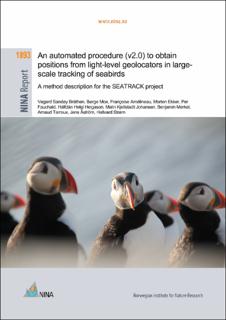An automated procedure (v2.0) to obtain positions from light-level geolocators in large-scale tracking of seabirds. A method description for the SEATRACK project
Bråthen, Vegard Sandøy; Moe, Børge; Amélineau, Françoise; Ekker, Morten; Fauchald, Per; Helgason, Hálfdán Helgi; Johansen, Malin Kjellstadli; Merkel, Benjamin; Tarroux, Arnaud; Åström, Jens; Strøm, Hallvard
Research report

Åpne
Permanent lenke
https://hdl.handle.net/11250/2735757Utgivelsesdato
2021Metadata
Vis full innførselSamlinger
- NINA Rapport/NINA Report [2341]
Sammendrag
Bråthen, V.S., Moe, B., Amélineau, F., Ekker, M., Fauchald, P.,Helgason, H.H., Johansen, M. K., Merkel, B., Tarroux, A., Åström, J. & Strøm, H. 2021. An automated procedure (v2.0) to obtain positions from light-level geolocators in large-scale tracking of seabirds. A method description for the SEATRACK project. NINA Report 1893. Norwegian Institute for Nature Research.
Partners in the SEATRACK project have since 2014 deployed >14 000 light-level geolocators on 11 species of seabirds to study their non-breeding distribution in the North Atlantic. Geolocator tags are ideal for large-scale tracking of seabirds being cheap and small. The tags contains a clock and a light sensor that register light levels at fixed intervals. These data are stored in the internal memory and are obtained when the tag is recovered from the bird. From these data two positions per day are calculated by estimating latitude from the length of day and night, and longitude from time of mid-day and mid-night. However, positions cannot be obtained from recorded light-data during the polar night or midnight sun. Further, the latitudinal accuracy is unreliable close to spring and autumn equinox when the length of day and night is similar across the earth.
Using a threshold method, we first identify twilight events, which is the time when light-levels cross a predefined threshold that separate day from night. However, the light-level recordings are affected by environmental factors and the behaviour of the bird that may shade the geolocator or expose it to artificial light. As such, the accuracy is low compared to GPS or Argos tracking devices. A common approach has therefore been to improve the identification of these twilight events by manually inspecting the light-level data. This process is, however, time-consuming and prone to not being fully consistent and reproducible among different persons applying it.
In this report, we describe an automated procedure (v2.0) for obtaining the basic positional dataset in SEATRACK from raw light-level data. The procedure automatically filters and edits the twilight events used for calculating positions. It further removes unrealistic positions using filters on equinox periods, speed, distribution, angle, distance, variation in timing of twilights and midnight sun periods, and produces double smoothed positions. Calibration of sun elevation angles, crucial for producing the final positions, is performed on each track and is the only part involving subjective assessment, but we show that it can be performed consistently and with a high repeatability.
SEATRACK processes light data from >1000 geolocators after each field season, and the database has become one of the largest seabird tracking databases in the world. The automated procedure (v2.0) is a very cost-efficient method for such large-scale tracking and is consistent and reproducible. We have recently updated the entire database using this procedure, replacing all previous data based on the manual procedure and the first version of the automated procedure (v1.0).
This report describes the methods used to obtain positions from geolocators in the SEATRACK project. As the described procedure replace our previous manual method, we show comparisons of the two procedures. The report also provides examples of how to read and visualize the positional data and can serve as the reference for the methods and as a tool for using the data.